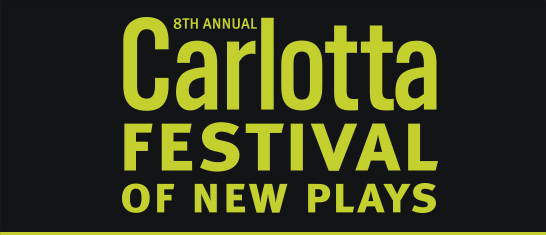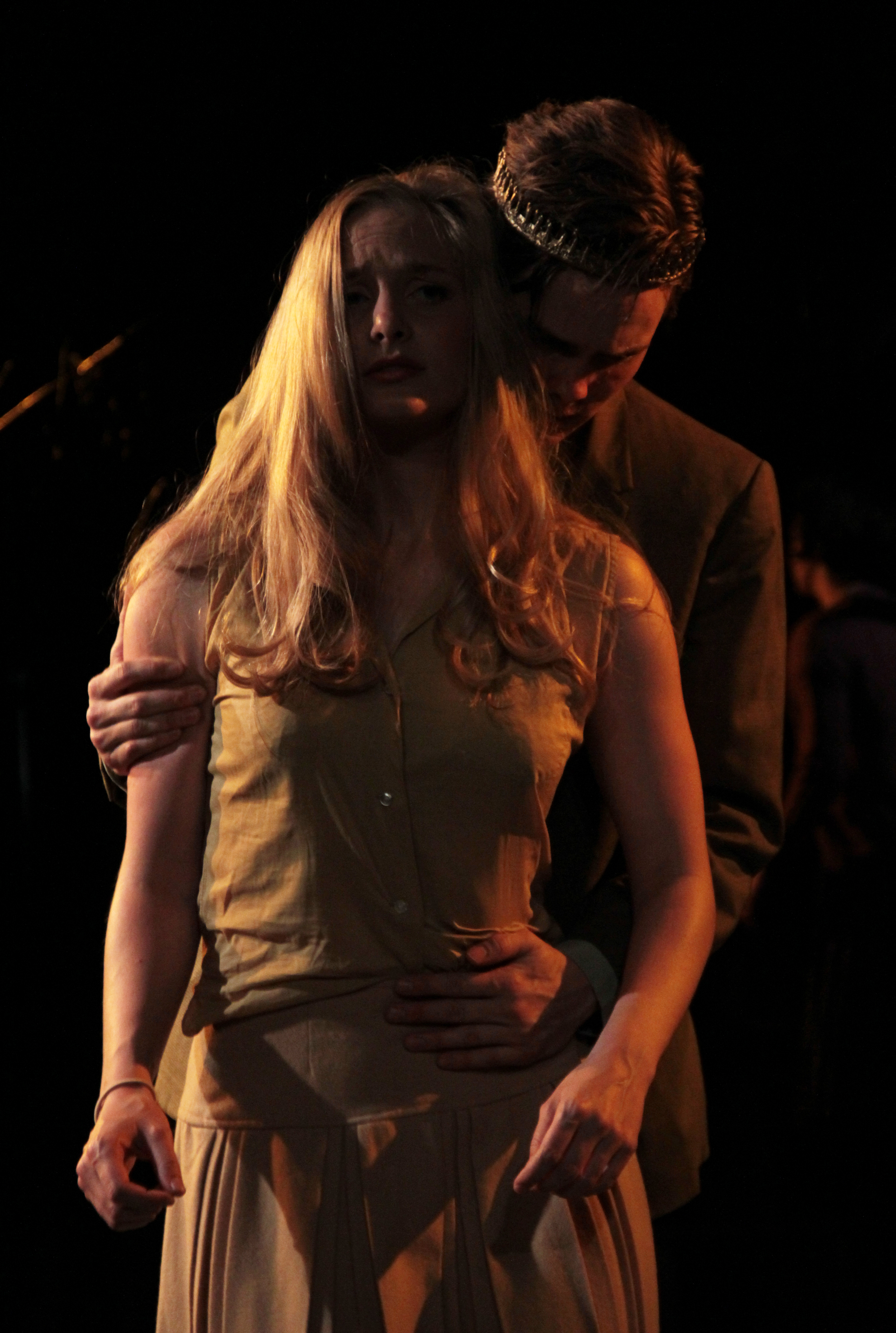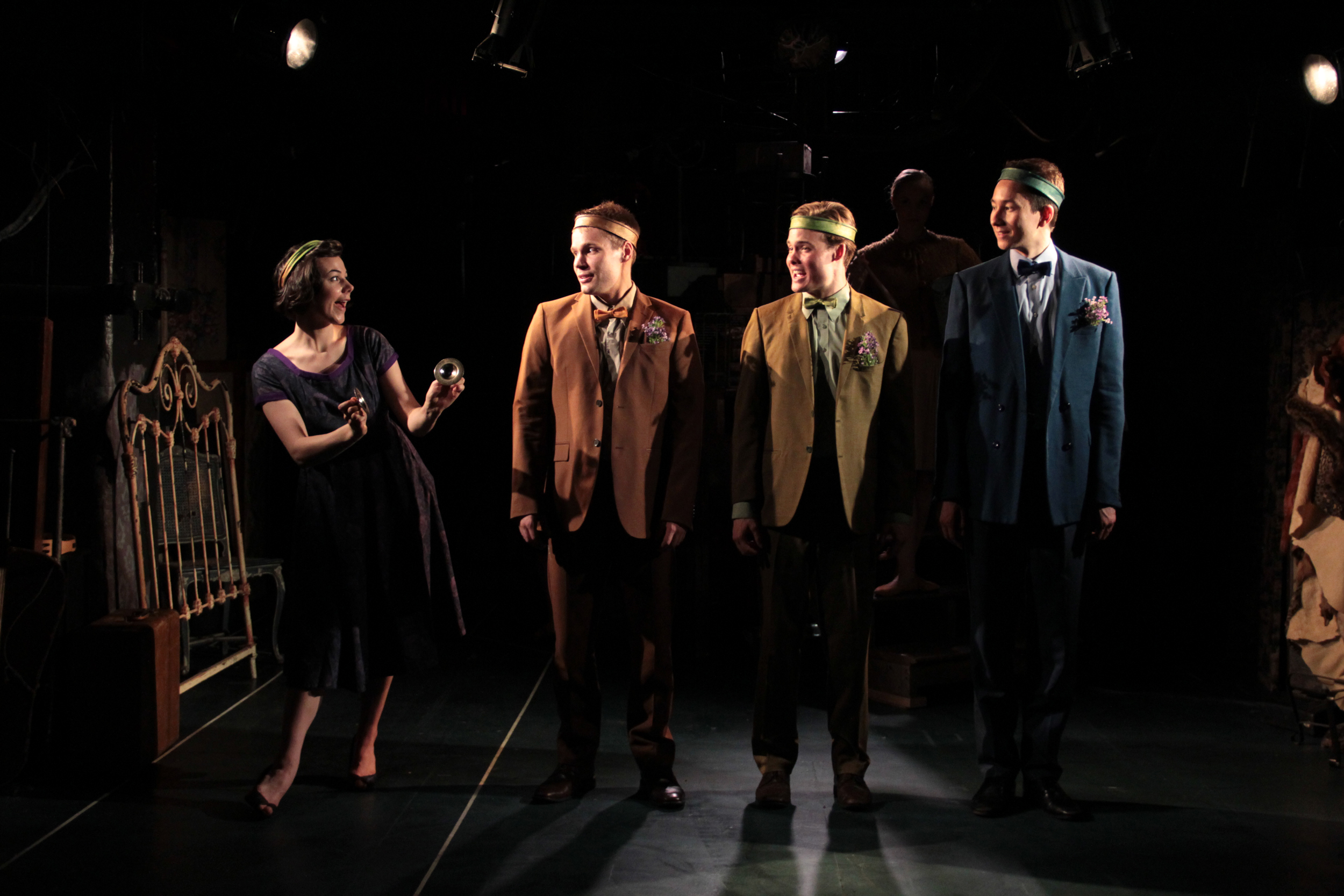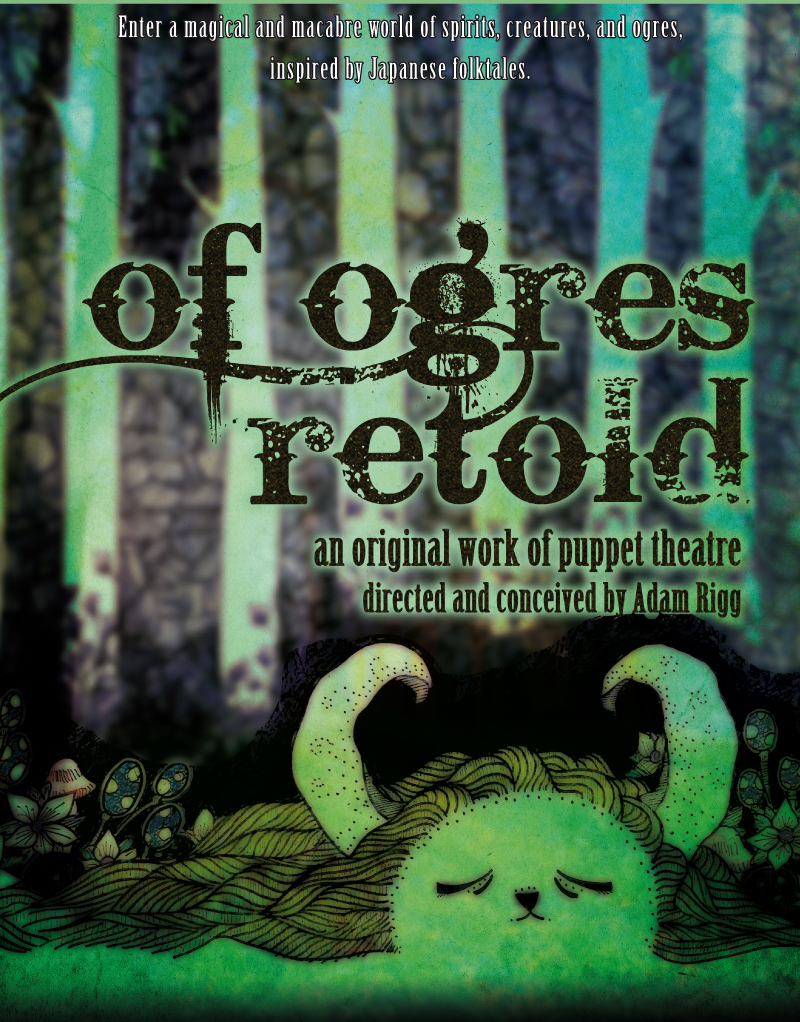The 45th Season of the Yale Cabaret closed last month, and before this month is out the latest version of the Yale Summer Cabaret—titled “A Summer of Giants”—will open. In the meantime, here is my recap of last season, picking my favorite shows and contributors in thirteen categories. In each, plays are listed in order of appearance, except for my top choice which comes last. Play (pre-existing work): Small casts—often only two actors—dominated the choices the Cab presented this year: White Rabbit, Red Rabbit, Nassim Soleimanpour’s interrogation of freedom, artistic purpose, and the value of theater was one of the more challenging nights at the Cab; Cowboy Mouth, Sam Shepard and Patti Smith’s riff on the agonistic love affair with rock’n’roll of two second-generation beat poets boasted great language and expressive movement; The Small Things, Enda Walsh’s speech-driven and static two-character play made almost all its bizarre and frightening action take place in the audience’s minds; Arnold Schoenberg and Alberg Giraud’s musical and poetic extravaganza, Pierrot Lunaire, was a feast for both eyes and ears, a dramatic achievement of the religion of art; and . . . The Island, Athol Fugard’s collaborative play with John Kani and Winston Ntshona, combined the intimate talk of two inmates in South Africa with their chosen roles as Antigone and Creon to create a powerful portrayal of the politics of art under repressive regimes.
Play (original): The plays originating with YSD students ran quite a gamut, the ones I liked best provoked visceral responses hard to ignore: Ain’t Gonna Make It, conceived by Nicholas Hussong, Cole Lewis, Masha Tsimring, Lauren Dubowski, and created by the Ensemble, presented entertaining songs and a stand-up routine about terminal illness early in life; Phillip Howze’s All of What You Love and None of What You Hate is a multi-character drama about teen pregnancy and coping, full of vibrant language and characterizations; Jackson Moran’s All This Noise offered one man’s take on a family tragedy and his personal outrage at mental health treatment in our country; The Bird Bath, created by the Ensemble, was an expressive and harrowing account of an artist’s mental dissolution told via expressive movement and voice-overs; and . . . This., script by Mary Laws, dramatized personal memories about moments of connection and disconnection in the New Haven and Yale communities to telling effect.
Sound: Sound can be a subtle category, sometimes a bit difficult to assess after the fact, and, when most effective, one tends not to notice it; my choices represent strong impressions that stayed with me: the busy soundscape of The Fatal Eggs (Matt Otto and Joel Abbott); the brash echoes on the voices of the poets in Cowboy Mouth (Palmer Hefferan); the aural mosaic of voice-overs, music, cell calls, and sound effects in All of What You Love and None of What You Hate (Pornchanok Kanchanabanca and Sang Ahm); the sound effects, voice-overs, use of music, all with a dated feel in Lindbergh’s Flight (Tyler Kieffer); and . . . the very effective interplay of sound, voice-over, and original music in The Bird Bath (Palmer Hefferan).
Music: Cab 45 was strong in shows involving original compositions, and for use of music as a major ingredient of the show: the songs of life, death, disease and defiance created and performed by the on-stage ensemble—Timothy Hassler, Hansol Jung, MJ Kaufman, Sarah Krasnow, Jenny Schmidt, and Lico Whitfield—in Ain’t Gonna Make It; the music created by Mickey Theis to accompany his character’s rock star posteuring in Cowboy Mouth; the tunefully Terpsichorean offerings—both in writing and playing—by Timothy Hassler and Paul Lieber in Cat Club; the moods of Palmer Hefferan’s original score for The Bird Bath; and . . . the first-rate performance of Schoenberg’s challenging score for Pierrot Lunaire, by Dan Schlosberg, piano; Clare Monfredo, cello; Jacob Ashworth, violin and viola; Ginevra Petrucci, flute and piccolo; Ashley Smith, clarinet and bass clarinet; and Virginia Warnken, soprano.
Lighting: To enjoy a play, you have to be able to see it, of course—but often Lighting goes well beyond mere illumination to become an expressive part of the play; some instances I was particularly struck by: Meredith Reis’s diverse sources of illumination and fun lighting effects in The Fatal Eggs; Oliver Wason’s dramatic lighting of tableaux moments in This.; Masha Tsimring’s evocative illuminations of the tripartite action of The Bird Bath; Joey Moro’s nimble lighting of the wacky subversions of Lindbergh’s Flight; and . . . Oliver Wason’s highly effective visual enhancement of Pierrot Lunaire.
Puppets, projections, props, and special effects: More than a few shows this year indulged in puppetry—shadow puppets and actual puppets—as well as a fair share of projections, videos, and engagement with unusual props; here are some stand-outs: the use of projections and props in All This Noise, Nicholas Hussong, projection designer; the shadow puppet miniatures that illustrated the story of Ermyntrude & Esmeralda, Lee O’Reilly, Technical Director; Joey Moro, Assistant Technical Director; Carmen Martinez, Puppetry Captain; the playful use of shadow puppets to tell one of the wild stories written by the twins in The Twins Would Like to Say, Whitney Dibo and Lauren Dubowski, Co-Directors; the projections and special effects that punctuated the lurid tale of The Ugly One, Nicholas Hussong, Projection Designer, Alex Bergeron, Technical Director; and . . . the evocative projections (Solomon Weisbard and Michael F. Bergmann) and flying puppets (Dustin Wills, with Nicole Bromley and Dan Perez, Technical Directors) that enlivened The Fatal Eggs.
Scenic Design: One of the great joys of the Cab is seeing how, with each new production, the space changes to be made to be what it has to be; some remarkable transformations include: the busy set and shenanigans, like swinging doors, in The Fatal Eggs (Kate Noll and Carmen Martinez); the sprawling Chelsea bohemia of Cowboy Mouth (Meredith Ries); the cartoonish play space of Milk Milk Lemonade (Brian Dudkiewicz, and Samantha Lazar, Assistant Set Designer); the three spaces with three different personalities of The Bird Bath (Mariana Sanchez Hernandez); and . . . the conceptualized prison commissary space with raised stage of The Island (Kristen Robinson).
Costumes: When it comes to transforming a group of actors, the effects are sometimes subtle, sometimes outlandish: the colorful clothing—where the shetl meets vaudeville—of The Fatal Eggs (Nikki Delhomme); the spot-on pre-punkdom, plus lobster suit, of Cowboy Mouth (Jayoung Yoon); the Edwardian filigree of Ermyntrude & Esmeralda (Seth Bodie); the dowdy get-ups and clownish make-up of The Small Things (Nikki Delhomme); and . . . Milk Milk Lemonade (Soule Golden): I’ll never forget Lico in a chicken suit, and whenever penis-pajamas catch on, say you saw them here first.
Ensemble: Just as technical effects are often achieved by collaboration, so are dramatic effects—the Cab thrives on ensemble work and here are some special commendations: the entire cast of The Fatal Eggs—Chris Bannow, Sophie von Haselberg, Dan O’Brien, Ceci Fernandez, Michelle McGregor, Mamoudou Athie, Ilya Khodosh—presenting a bizarre collection of types; the entire cast of This.—Jabari Brisport, Merlin Huff, Ella Monte-Brown, Mariko Nakasone, Hannah Sorenson, Mickey Theis—for superlative interactions and transformations, independent of gender considerations; the entire cast of Milk Milk Lemonade—Xaq Webb, Bonnie Antosh, Melissa Zimmerman, Lico Whitfield, Heidi Liedke—some of whom aren’t YSD students, for their game enactment of this colorful tale; our avatars and others in the audience-participation odyssey, Dilemma—Ben Fainstein, Hugh Farrell, Sarah Krasnow, Rachel Carpman, Zach LeClair, and Dan Perez—for taking us where we told them to go; and . . . Zie Kollektief—Kate Attwell, Gabe Levey, Brenda Meaney, Mitchell Winter—who broke down the Brechtian effort to break down “the walls,” with a vengeance, in Lindbergh’s Flight.
And special mention to the volunteers who bravely enacted, with audience members, White Rabbit, Red Rabbit, script sight-unseen: Sara Holdren, Monique Barbee, John-Michael Marrs, Hugh Farrell, Gabriel Levey, Brian Smallwood.
Actor: We’re always looking for a star, even in the midst of ensemble; for notable individual performances by a male actor: Timothy Hassler, as the terminally ill and memorably entertaining Eric in Ain’t Gonna Make It; Mickey Theis, as Slim, the guitar-wielding shit-kicker turned rocker in Cowboy Mouth; Paul Pryce, as John, the apartheid inmate with a vision of Antigone in The Island; Christopher Geary, as the self-questioning survivor in The Small Things; and . . . Jackson Moran, in All This Noise, for playing, more or less, himself in a one-man show that confronts the drama, sorrow and joys of real life and the realities of mental problems.
Actress: What moves us most in watching acting varies, but we know when an actress makes a part her own: Michelle McGregor, as the poet-groupie-Svengali called Canavale in Cowboy Mouth; Zenzi Willliams, as the teen, passive to the point of persecution in All of What You Love and None of What You Hate; Ceci Fernandez, as the innocent but pining for knowledge Esmeralda in Ermyntrude & Esmeralda; Emily Reilly, as the lonely woman with a tale to tell in The Small Things; and . . . Hannah Sorenson, as the schizophrenic Lenora Carrington—vomiting, bathing, withdrawing, and transcending—in The Bird Bath.
Direction: With so much going on that’s worth watching, who keeps it all together and makes sure it all comes off? The director, we assume; some special mentions: Dustin Wills, for the zany Soviet sci-fi extravaganza of The Fatal Eggs; Kate Attwell, for the gripping anti-apartheid drama of two prisoners learning what they represent in The Island; Monique Barbee, for the three-at-once manifestation of psychic distress and coping in The Bird Bath; Ethan Heard, for the creation of actions to illuminate rich compositions of poetry and music in Pierrot Lunaire; and . . . Margot Bordelon, for the subtle and sensitive enacting of the stories people tell (and don’t tell) about themselves in This.
Production: For overall production, it's no surprise that the favorites in other categories line up at the end; I've already acknowledged the directors of these shows, now it's time for the producers: This., produced by Whitney Dibo, with its strong ensemble work and vivid presentation, gave us insight into one another and ourselves; The Island, produced by Lico Whitfield, with its strong dialogue and innovative set, presented us with a visceral sense of theater’s power; The Bird Bath, produced by Emika Abe, with its mystery and misery, provided a sense of convulsive beauty (a surrealist mantra); Pierrot Lunaire, produced by Anh Le, showed us the sublime possibilities of musical theater; and . . . The Fatal Eggs, produced by Melissa Zimmerman, immersed us in the wild energy, complex staging, and surprise effects possible only at the Yale Cabaret.
That’s it for this year. Our thanks and best wishes to all who participated in the shows of the 45th season, and to all the staff, especially Artistic Director Ethan Heard, who chose the season, and Managing Director Jonathan Wemette, who kept it running so smoothly, and . . . see you next year for season 46: Whitney Dibo, Lauren Dubowski, and Kelly Kerwin, a trio of YSD dramaturgs will be, collectively, the Artistic Directors, and Shane D. Hudson will be the Managing Director, a post he filled in last year’s Summer Cabaret. Speaking of the Summer Cabaret, stay tuned for a preview with Artistic Director Dustin Wills of its offerings, which begin May 30th and end August 18th.
The Yale Cabaret 45th Anniversary Season Artistic Director: Ethan Heard Managing Director: Jonathan Wemette Associate Artistic Director: Benjamin Fainstein Associate Artistic Director: Nicholas Hussong







